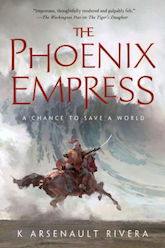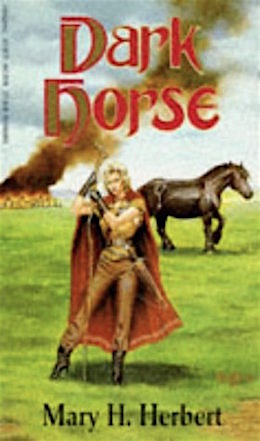As summer finally fades—though here in Arizona, that is a very long process indeed, with heat that persists all the way through October until that final, blessed break into winter—I’ve continued the Summer Reading Adventure, but with a shift as the season changes, from longtime favorites to a couple of recommendations from commenters. This time, I’m reading Mary H. Herbert’s Dark Horse, first of a series published from 1990 until about 1996. I missed it when it first came out, so it’s completely new to me. Next time I’ll dive into Kristen Britain’s Green Rider, which has been in my TBR pile literally forever. Finally, I say. Finally! I shall read it!
So then. Dark Horse.
Gabria is the last survivor of a clan of nomadic horsemen massacred by an evil sorcerer. She swears vengeance, but the only way she knows to achieve it in her extremely sexist society is to disguise herself as her late twin brother and seek the support of her long-dead mother’s powerful clan. It’s a capital offense for a woman to impersonate a man, but she is deathly determined to challenge the evil Medb to a duel.
The Dark Horse of the title is a mare named Nara. She is one of a rare breed of magical horses, the Hunnuli, who can only be tamed by the greatest of warriors. It’s a capital offense for a woman to do this, too.
While on her way to the Khulinin, Gabria finds Nara trapped in a bog. With tremendous effort over a period of days, she digs the mare out and sets her free. The mare, she sees in the process, is in foal.
Nara runs off at first, but then calls telepathically to Gabria, begging for help. She has gone into labor and the foal is blocked. Gabria discovers the worst of equine dystocias: forelegs stretched out in diving position as is proper, but neck bent in half and head facing backwards, blocked by the mare’s pelvis.
Gabria manages to extract the foal, but he is dead. Nara survives and offers to pay her debt by helping Gabria reach the Khulinin. Nara grieves but not unduly. There will be other foals, she says.
Gabria does indeed make her way to the Khulinin. Nara is her passport: there is only one other Hunnuli in the clan, Boreas, a stallion ridden by the clan leader’s son Athlone. Gabria manages to be accepted on a probationary basis, keeps her gender secret, mostly manages to pull off the masquerade, and trains as a warrior. She acquires an enemy, the drunken and vindictive coward Cor, and a friend, also an outlander, the healer Piers. The clan chieftain, Savaric, rather takes to her. Athlone does not: he senses something off about her.
In due time he discovers what it is. It’s a classic scene: Gabria runs off, encouraged by Nara, to take a very long overdue bath (like, months, during which she seems to have refrained from urinating, defecating, or menstruating, and has somehow managed not to reek to high heaven), and Athlone finds her. Nara manufactured this encounter to force Gabria to accept Athlone’s help—and just happens to use the opportunity to have some quality time with Boreas.
Athlone comes around extremely rapidly, considering the strength of the prohibition against women warriors. Piers has also figured out Gabria’s secret. The three of them work out a way to train Gabria for the duel against Medb while concealing her secret from the rest of the clan.
Cor becomes a serious problem. He attacks Gabria, and she essentially castrates him with sorcery. Later he comes after her again, and this time she kills him, again with sorcery. And that, along with everything else about her, is a capital offense.
Soon enough, Medb makes his move against all the clans and especially the Khulinin. Gabria is all set to challenge him to a duel with swords, but discovers to her horror that she can’t. He’s a cripple. He broke both his legs trying to tame a Hunnuli, who fling himself off a cliff rather than serve an evil sorcerer.
There is only one thing for Gabria to do, according to all of her advisors: find the Woman of the Marsh and learn to use her powers, and challenge Medb with those. Meanwhile Medb has driven the Khulinin and a handful of loyal clans into an ancient imperial fortress and laid siege. In the ensuing battle, Boreas dies and Athlone is captured.
Gabria has her own difficult odyssey to face, the last of it without Nara, who can’t penetrate the mud of the marshes. An otter guides Gabria to the Woman, who teaches her everything she knows in two days, then exacts a price she is not…quite honest about, and sends Gabria out to challenge Medb.
Of course Gabria wins and Athlone is saved, but the price is to be forcibly summoned back to the marsh and have her consciousness transferred to the crone’s body, while the crone takes her youth and her life. Gabria resists just long enough for Athlone to come roaring in and kill the sorceress. And then he and Gabria get it together, until they have to go back to the clan because Savaric has died and Athlone has to take over the lordship.
Gabria is tried for her many infractions, but everybody has come around, however reluctantly, to the fact that her sorcery saved them. They don’t like it but they can’t deny it. Her sentence is to marry Athlone, which she doesn’t mind at all. And Nara is pregnant by Boreas, and all’s well that ends as well as can be expected.
It seemed to me as I read the first two-thirds of Dark Horse that it’s a response to, and maybe antidote for, not just Red Moon and Black Mountain but its later and even more problematical sequel, The Grey Mane of Morning. Here are the heavily patriarchal horse clans with their lovely horses and their mustached chieftains, the women relegated to extreme insignificance, and even a nod to the bronze-golden Dur’chai in the bright flaxen chestnut king stallion of the Khulinin (Kh-named like the Khentors), though in Tolkienesque fashion he’s referred to as the meara. There’s a healer with a strange past, a royal heir who becomes the protagonist’s teacher, and an evil sorcerer who is out to destroy the lifestyle and culture of the clans. One thing Chant does better than Herbert, and way better, is racial diversity—the racism here (along with the ableism) is not a small problem for me, here in 2018.
Then in the last third, everything goes Tolkien. The clans retreat to Helm’s Deep, except the caves kind of get lost in the confusion and they’re living in sort-of-Minas Tirith. There’s even a river Isin that runs through the deep ravine, and a gate that gets blown open by evil magic. Gabria’s ordeal in the marsh is a bit like the Dead Marshes with a touch of Narnia, complete with neeker-breeking insects and nassty ssstinking mud. But if the sorceress is meant to remind us of the sorceress of the Golden Wood, well, uh. Nope.
As with Chant’s books, the horses start off strong but dribble away to nothing by the end. It’s a clear case of too much boyfriend, not enough roller derby. The end is a clinch between Gabria and Athlone, when really, come on, what happened to Nara? Gabria met her first, and she’s done way more to get Gabria where she’s going than Athlone has. Why doesn’t she get at least the penultimate word?
Nara is interesting. She makes me think Herbert saw Ladyhawke as so many other fantasy fans did, and fell madly in love with Goliath, the gorgeous big black Friesian who is as much a character in the film as his rider, Navarre. I can’t say I blame her. He was something.
But Nara is a mare, and that’s radical in a genre that leans so heavily toward stallions. She’s oversized in fantasy-horse fashion, eighteen hands, but I have to give credit: a horse that size is not outside the realm of plausibility, and it is possible to mount one, though you need either a tall mounting block, a strong leg up, or a great deal of athletic ability. That’s six feet at the withers, so a fair ways up.
Buy the Book


The Phoenix Empress
It’s clear Herbert knows horses. She’s studied foaling and understands some key basics, including the worst way for a foal to present, and what happens when the water breaks but the foal doesn’t emerge within half an hour or so. What she misses in the mud-trap scene is that a horse trapped for days doesn’t just need to eat—she needs to drink. Gabria never once gives Nara water, though she feeds her. Nara would in reality have emerged, foaled, and then died of impaction colic.
But hey. Magical horse. I appreciated the mark of magic on all the Hunnuli: a white lightning slash on the shoulder. Many years before Harry Potter, another magical being pioneered this distinctive label.
Nara has a lot more to say to Gabria than Dur’chai ever said to Oliver. She’s telepathic and she speaks her mind early and often. She offers advice, gives instructions, and sets Gabria straight when she threatens to stray irredeemably into the weeds. Gabria is frequently stupid and a considerable twit; often, she’s quite simply a stupid twit. Nara goes her best to compensate for it.
Unfortunately for my taste in horse stories, Nara never quite fulfills her potential. As soon as the plot shifts from Chant to Tolkien, the horses drop off the radar. Boreas gets killed off, but at least it happens onstage—unlike Savaric, who just suddenly isn’t there any more. Nara serves as transportation to the marsh but can’t make it all the way, which is justified in context—we’re called on to remember how she and Gabria met—but she’s telepathic, she’s magical, surely she could do something more than she does. And then at the end, as I noted, instead of appearing in the denouement, she just isn’t there. Instead it’s all about Athlone.
Still. A mare, and one who does what a mare does when she has access to a stallion, is unusual in modern fantasy. I appreciate that.
Judith Tarr is a lifelong horse person. She supports her habit by writing works of fantasy and science fiction as well as historical novels, many of which have been published as ebooks by Book View Cafe. She’s even written a primer for writers who want to write about horses: Writing Horses: The Fine Art of Getting It Right. Her most recent novel, Dragons in the Earth, features a herd of magical horses, and her space opera, Forgotten Suns, features both terrestrial horses and an alien horselike species (and space whales!). She lives near Tucson, Arizona with a herd of Lipizzans, a clowder of cats, and a blue-eyed dog.










